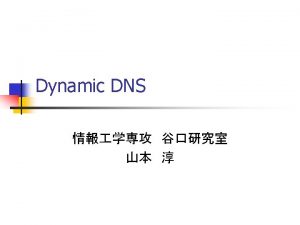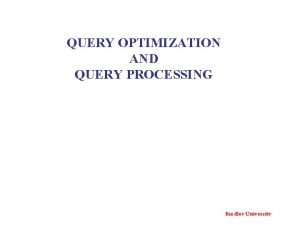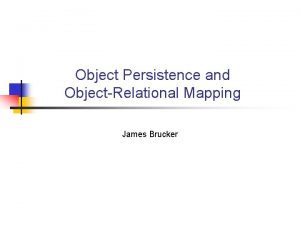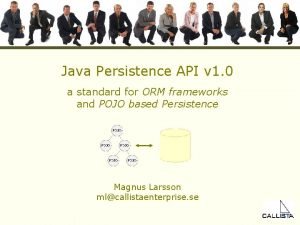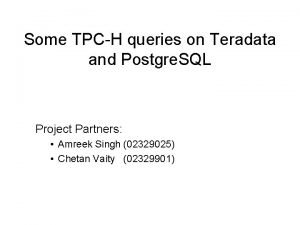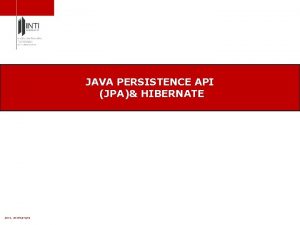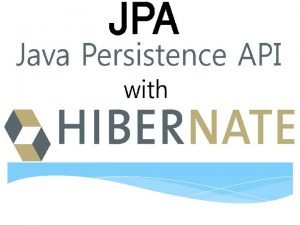IS907 Java EE JPA Queries Java Persistence Query











- Slides: 11

IS-907 Java EE JPA Queries

Java Persistence Query Language (JPQL) • designed to resemble SQL • • but selects entity objects rather than rows from tables A very simple query to select all persistent employee objects: SELECT e FROM Employee as e IS-202 - Course Info 2

JPQL – simple SELECT clauses • Because we are dealing with objects we can use the dot (. ) notation to select properties from objects. This is called a path expression: SELECT e. name FROM Employee e • It is also possible to select related entities: SELECT e. department FROM Employee e • and even attributes of related entities: SELECT e. department. name FROM Employee e • All these queries return lists of objects (List<String>, List<Department>, and List<String>). IS-202 - Course Info 3

JPQL – Where clauses • We can use WHERE clauses to restrict the number of entities found: SELECT e FROM Employee e WHERE e. department. name = ‘STAB’ • The condition can contain path expressions, constants and operators • Comparison: =, >, <, >=, <>, LIKE, BETWEEN • Logical: AND, OR, NOT IS-202 - Course Info 4

JPQL - JOINs • Entities can be joined using the WHERE clause: SELECT e. name FROM Employee e, Department d WHERE e. department = d AND d. name LIKE ‘S%’ • or using the JOIN operator: SELECT e. name FROM Department d JOIN d. employees e WHERE d. name LIKE ‘S%’ • Using the JOIN operator is the preferred way. IS-202 - Course Info 5

Using queries • The Entity. Manager can create query objects: Typed. Query<Department> q = em. create. Query("select d from Department as d“, Department. class); List<Department> deps = q. get. Result. List(); • The parameter is a query in the Java Persistence Query Language (JPQL) • JPQL resembles SQL but java types and expressions are used rather than the tables and columns in SQL. • get. Result. List() returns a list of the objects found by the query. Query objects have other methods that can be used in special situations (e. g. get. Single. Result() if the query returns only a single object) IS-202 - Course Info 6

JPA – Parametrized JPQL queries • Just as in JDBC we can have parameters in queries • We can use parameter names rather than numbers: Entity. Manager em; Typed. Query<Employee> q = em. create. Query(“SELECT e FROM Employee e “ +”WHERE e. name LIKE : pattern”, Employee. class); q. set. Parameter(“pattern”, “%en”); List<Employee> result = q. get. Result. List(); • The same parameter can occur several times in the query if the value is needed in more than one place (e. g. in a complex WHERE clause) IS-202 - Course Info 7

JPA – Defining Named Queries • Queries are faster and safer if they can be precompiled. • @Named. Query annotations can be used to define queries (usually with parameters) that will be compiled when the application is deployed. @Entity @Named. Queries({ @Named. Query(name=“Employee. find. By. Name” query=“SELECT e FROM Employee e WHERE name like : p”), . . . }) public class Employee {. . } IS-202 - Course Info 8

JPA – Using Named Queries • Named Queries are used in a similar way to dynamic queries: Entity. Manager em; Typed. Query<Employee> q = em. create. Named. Query(“Employee. find. Name”, Employee. class); q. set. Parameter(“p”, “%en”); List<Employee> result = q. get. Result. List(); • The difference is faster execution: • The SQL code has been created in advance • and it can be precompiled (like a JDBC Prepared. Statement) IS-202 - Course Info 9

JPQL – Selecting multiple values • It is possible to SELECT more than one expression, e. g. : SELECT e. name, d. name FROM Department d JOIN d. employees e ORDER BY e. name • This query creates an alphabetical list of names and their department. • The return type is a list of Object[], which could be printed like this: List<Object[]> result = q. get. Result. List(); for (Object[] row : result) { System. out. print(row[0]+”t”); // the employee name and a tabulator System. out. println(row[1]); // the department name } IS-202 - Course Info 10

JPQL – Aggregate Queries • Query results can be aggregated using the functions AVG, COUNT, MAX, MIN, and SUM • Find the average salary: SELECT AVG(e. salary) FROM Employee e • Find the number of employees and max salary in each department: SELECT d. name, COUNT(e), MAX(e. salary) FROM Department d JOIN d. employees e GROUP BY d. name IS-202 - Course Info 11
 Is 907 active shooter
Is 907 active shooter Iterative vs recursive dns
Iterative vs recursive dns Query tree and query graph
Query tree and query graph Query tree and query graph
Query tree and query graph Java persistence architecture
Java persistence architecture Object persistence in java
Object persistence in java Java object persistence
Java object persistence Object persistence in java
Object persistence in java Dali java persistence tools
Dali java persistence tools Object persistence in java
Object persistence in java Teradata ordbms
Teradata ordbms Data manipulation language in sql
Data manipulation language in sql

